In this article, I will explain what exactly an erratum is, what purposes they may serve, and give examples of cards that Konami changed.
What Exactly IS An Erratum?
Simply put, an erratum is a change in a card's text. This usually involves adding or subtracting a few words, changing syntax, or shortening phrases on a card. Konami usually does this to update old cards and make them legible in today's terms.
Konami usually makes one of three changes to a card text, depending on a few factors. They may add Problem Solving Card Text (PSCT) to older cards, add some sort of restriction to banned cards, or make some "Quality of Life" (QoL) improvements to make card text shorter. In the next few sections, I will be explaining each type of errata and explaining why they are important.
Adding PSCT To Older Cards
The first type of errata made to cards usually only applies to cards released before August 16, 2011. Generation Force is the first booster set to introduce the idea of PSCT.
But what exactly IS Problem Solving Card Text? PSCT is a way of organizing card text in such a way where you are able to find out relevant activation and effect conditions on the card without having to read too much into the card's meanings. Simply put, it helps separate "costs" and "activation requirements" from effects. if you want a more in-depth look into this, please take a look at this article written by my colleague MapleBlade.
Another way that this type of errata changed card texts was that it made them shorter.
What do I mean by that? Well, let me introduce you to ...
The Horrors of Pre-PSCT Yu-Gi-Oh!
I will be going over a few examples of cards that were greatly changed by errata.
 Monster Reborn
Monster Reborn
Let me take you back to the barren landscape of LOB Yugioh. Specifically, let me bring you to one of the most iconic cards in the game: Monster Reborn. The most recent edition of the card, released in Starter Deck: Powercode Link, reads:
"Target 1 monster in either player's GY; Special Summon it."
Simple, right? This card tells you that you can summon a monster from any GY, and we know that it can be in Attack or Defense Position. When Konami first released it in LOB, however, it read as such:
"Select 1 Monster Card from either your opponent's or your own Graveyard and place it on the field under your control in Attack or Defense Position (face-up). This is considered a Special Summon."
Quite the mouthful, isn't it? The problem with this card is that it had too much information written on it. In the first and second errata, this card was shortened, and the third one updated it with PSCT.
Where is the Rest of the Card Text?
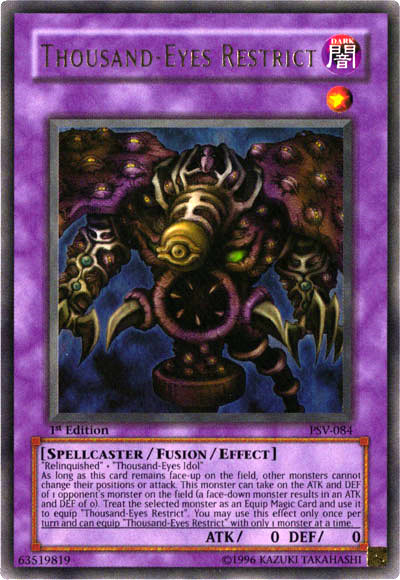 Say this effect in one breath.
Say this effect in one breath.The first iteration of Thousand-Eyes Restrict had a card text seemingly so long that its full effect wasn't even on it. Released in Pharaoh's Servant, it read:
"As long as this card remains face-up on the field, other monsters cannot change their positions or attack. This monster can take on the ATK and DEF of 1 opponent's monster on the field (a face-down monster results in an ATK and DEF of 0). Treat the selected monster as an Equip Magic Card and use it to equip "Thousand-Eyes Restrict". You can use this effect only once per turn and can equip "Thousand-Eyes Restrict" with only 1 monster at a time."
With an effect text so long, what could be missing? Well, as later errata specified, if it would be destroyed by battle, it can destroy the equip card instead.
Today the effect reads:
"Other monsters on the field cannot change their battle positions or attack. Once per turn: You can target 1 monster your opponent controls; equip that target to this card (max. 1). This card's ATK?DEF become equal to that equipped monster's. If this card would be destroyed by battle, destroy that equipped monster instead."
Why Is This Important?
If it wasn't obvious by now, this type of errata is extremely important. By adding PSCT and changing syntax, it makes the card game easier for newer players to take up. Not only that, but these errata also help all players actually understand what their cards to, and how they can interact with other effects.
Adding Restrictions to Cards
If you have read my previous articles on why Konami banned certain cards, you'll remember that I mentioned erratas. It can allow a card to return by adding some sort of restriction or cost to the card. So far, we have had a few cards come off the list because they received an erratum. I will go over a few types of restrictions, and some cards affected.
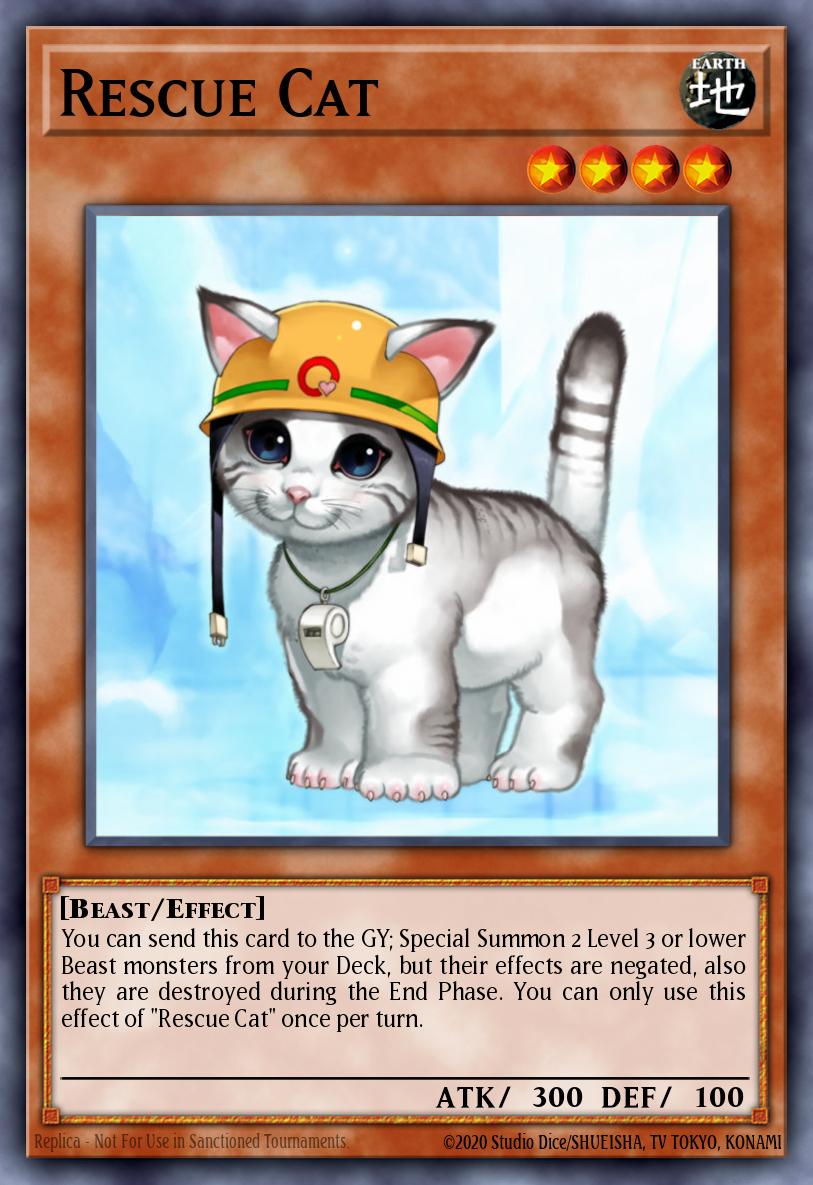 Monsters summoned also had their effects negated.
Monsters summoned also had their effects negated.Once Per Turn/Duel
One of the most common types of restrictions Konami placed on cards was by limiting how many times that card can be used. Usually, these cards received a "Hard" once-per-turn effect, meaning that you can only use a card with that name one time per turn. "Soft" once-per-turn effects can be used multiple times per turn if it is used with different copies of the card, or if that card leaves the field and comes back.
The most common - and effective - type of restriction was the HOPT. Cards like Rescue Cat and Grandsoil the Elemental Lord received this type of errata, effectively stopping any sort of loops made with them.
However, in the case of Destiny HERO - Disk Commander, Konami gave it a Once per Duel restriction on it, likely due to what seems to be their hard take on draw cards.
Limited Targets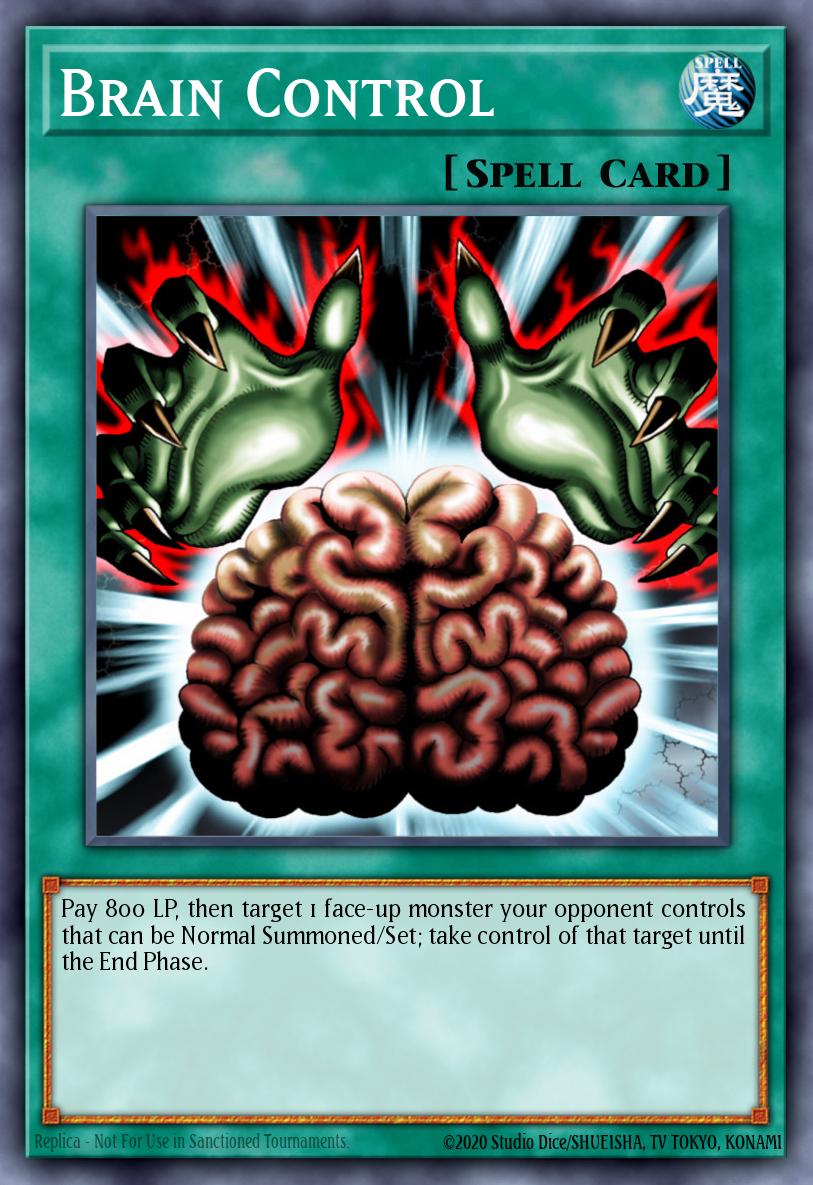
Another type of errata given to cards is one that limits the cards that they can target. One example of a card that does this is Brain Control. Prior to its errata in Duelist Saga, it allowed you to take control of any monster by paying 800 LP. With the most recent errata, the activation cost remains the same. However, Konami added a line of text to the card:
"Pay 800 LP, then target 1 face-up monster your opponent controls that can be Normal Summoned/Set; take control of that target until the End Phase."
Now, the amount of monster cards that it can affect has become considerably smaller. Nowadays, almost no one plays the card, because nearly all decks today use monsters that can only be Special Summoned.
But if your locals are filled with True Draco players, feel free to side this card, or even main it. You can steal their monsters with it.
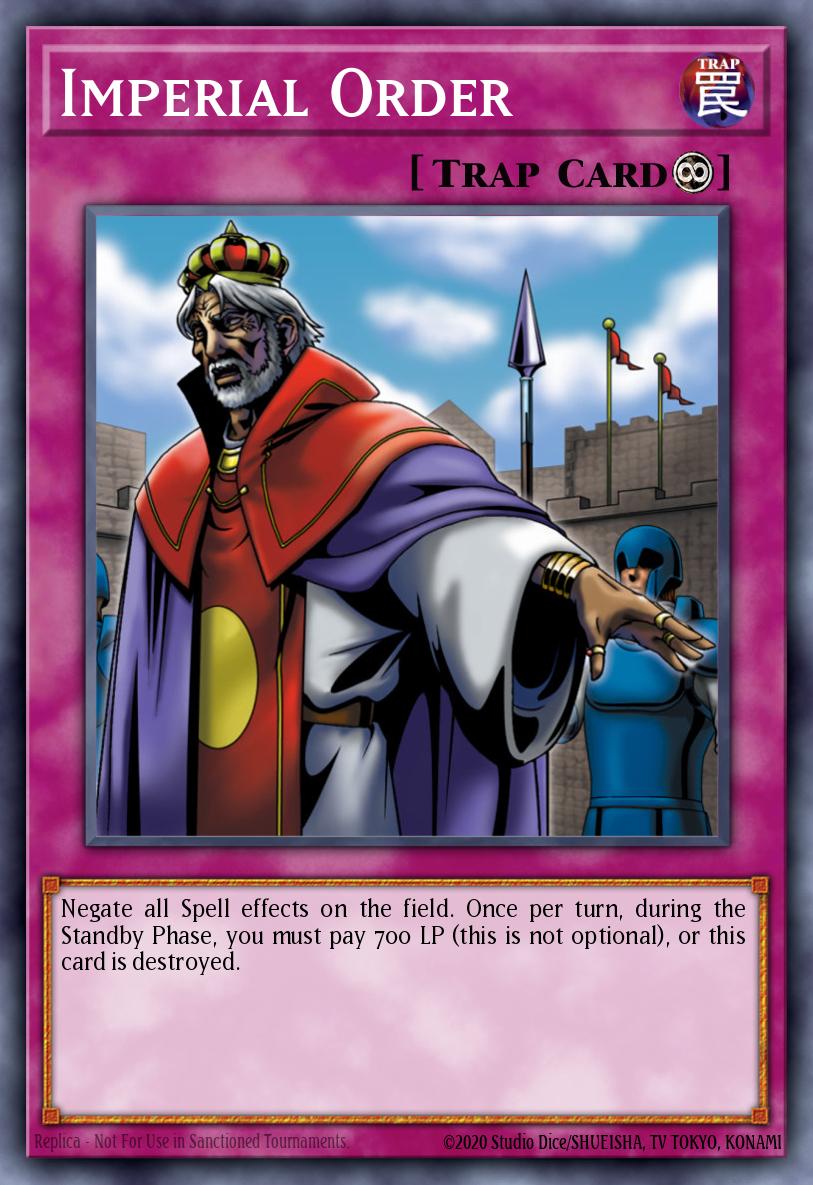 Changes in Activation/Maintenance Costs
Changes in Activation/Maintenance Costs
Konami released this next set of erratas to change the costs of using cards. The most popular example of a maintenance cost changing is with the card Imperial Order. During all errata, it negated Spell effects. However, prior to Duelist Saga, you only needed to pay its maintenance cost during your Standby Phases, and it was optional. Thus, you can choose to not pay the cost and destroy the card, thus allowing you to use Spells on your own turn.
Konami banned the card because it was extremely one-sided. Its erratum in Duelist Saga now reads:
"Once per turn, during the Standby Phase, you must pay 700 LP (this is not optional), or this card is destroyed."
Konami doubled the maintenance cost (each turn instead of your own), and made it not optional. This was deemed enough to bring the card to 1.
However, many don't think it's enough since the length of games is often short enough that the increased cost doesn't become relevant in most games.
Quality of Life Improvements
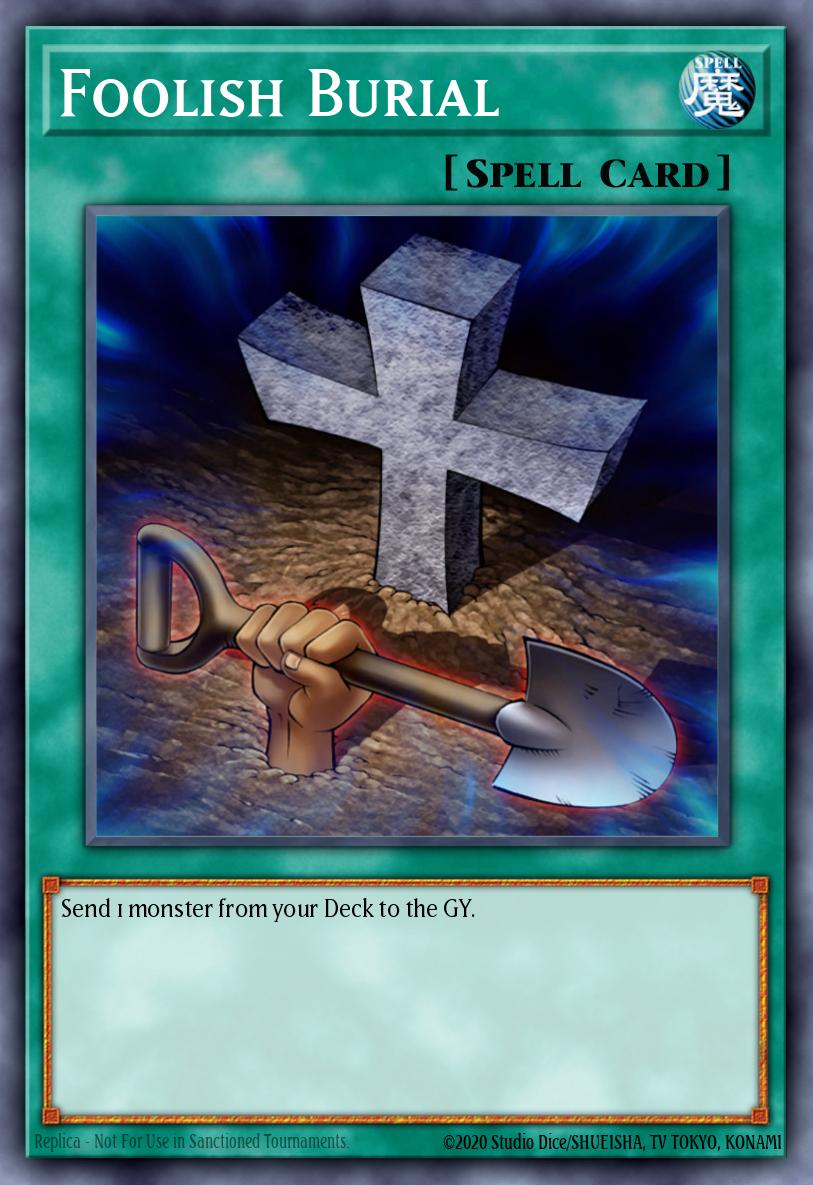 "Graveyard" became "GY" in the most recent errata.
"Graveyard" became "GY" in the most recent errata.The most recent type of errata that Konami introduced is one that affects card text length (without changing PSCT or syntax). This phenomenon was first seen in Starter Deck: Link Strike at the beginning of the Link era.
What this did is abbreviate, and in general shorten, common text in Yu-Gi-Oh cards. Konami shortened "Graveyard" and Spell and Trap cards to "GY" and S/T, respectively. They also changed Increasing/decreasing LP to "gain" or "lose" LP. Among other changes to this was the change in the specification of materials in monsters like Fusion or Synchro monsters. As an example, Trishula, Dragon of the Ice Barrier used to specify its materials in this way:
"1 Tuner + 2 or more non-Tuner monsters".
With its newest erratum, Konami shortened it to:
"1 Tuner + 2+ non-tuner Monsters".
Change like this serve to make card texts even shorter and easier to digest.
Cards Made More Powerful with Errata
For this section, I will talk about cards that whose errata inadvertently made them more powerful than they used to be. I will be going over a few examples of cards that became much better after Konami's erratum.
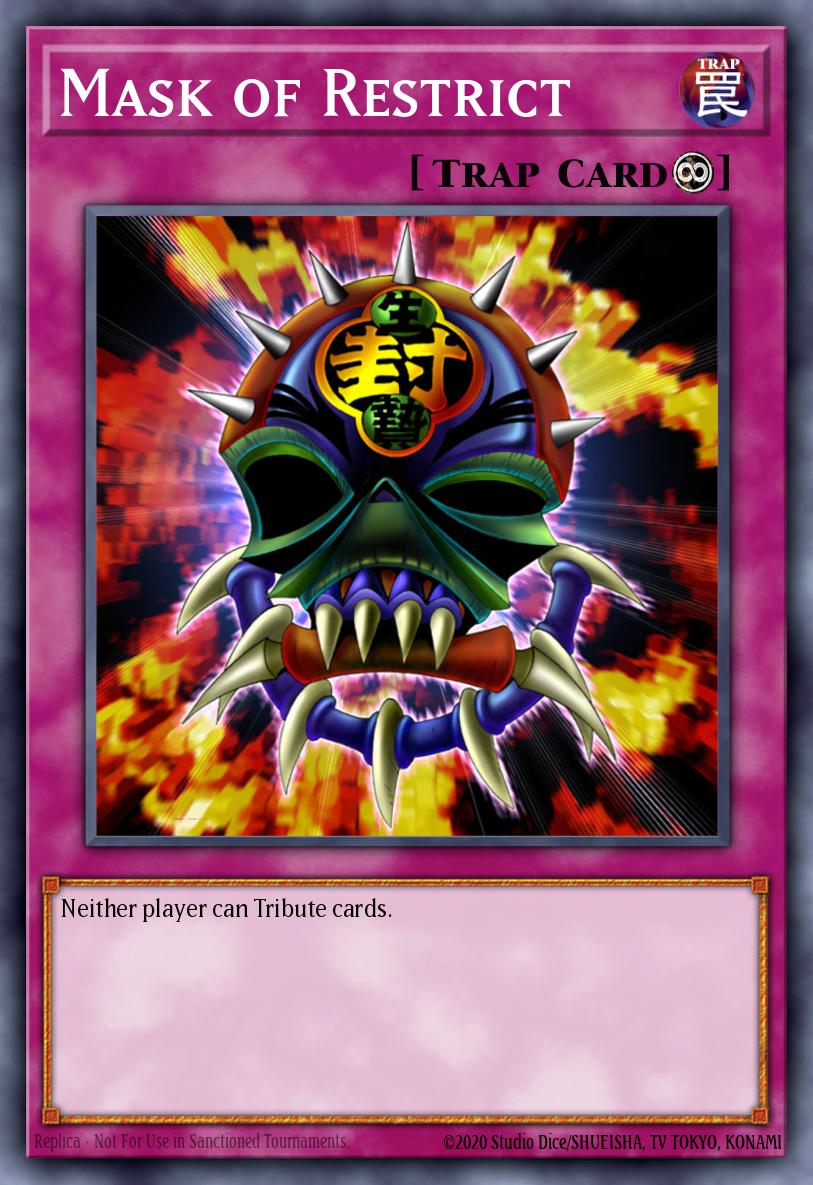 Where Exactly Can I Not Tribute?
Where Exactly Can I Not Tribute?
Mask of Restrict, first released in Labyrinth of Nightmare, read as follows:
"No matter what the situation, neither player can offer any monster as a Tribute."
I personally find it hilarious that it needs to specify "no matter what the situation" when you can already infer it from the latter part of the text.
However, its errata made it more powerful. Today, it reads:
"Neither player can Tribute cards."
With how it is worded, that means that not only does it prevent monsters from being Tribute Summoned, but it prevents effects that include Tributing. No one would be able to activate Cards that require a Tribute as an activation cost. Decks like True Draco would be unable to Tribute Summon their own monsters by Tributing their S/T cards.
Which One Are We On?
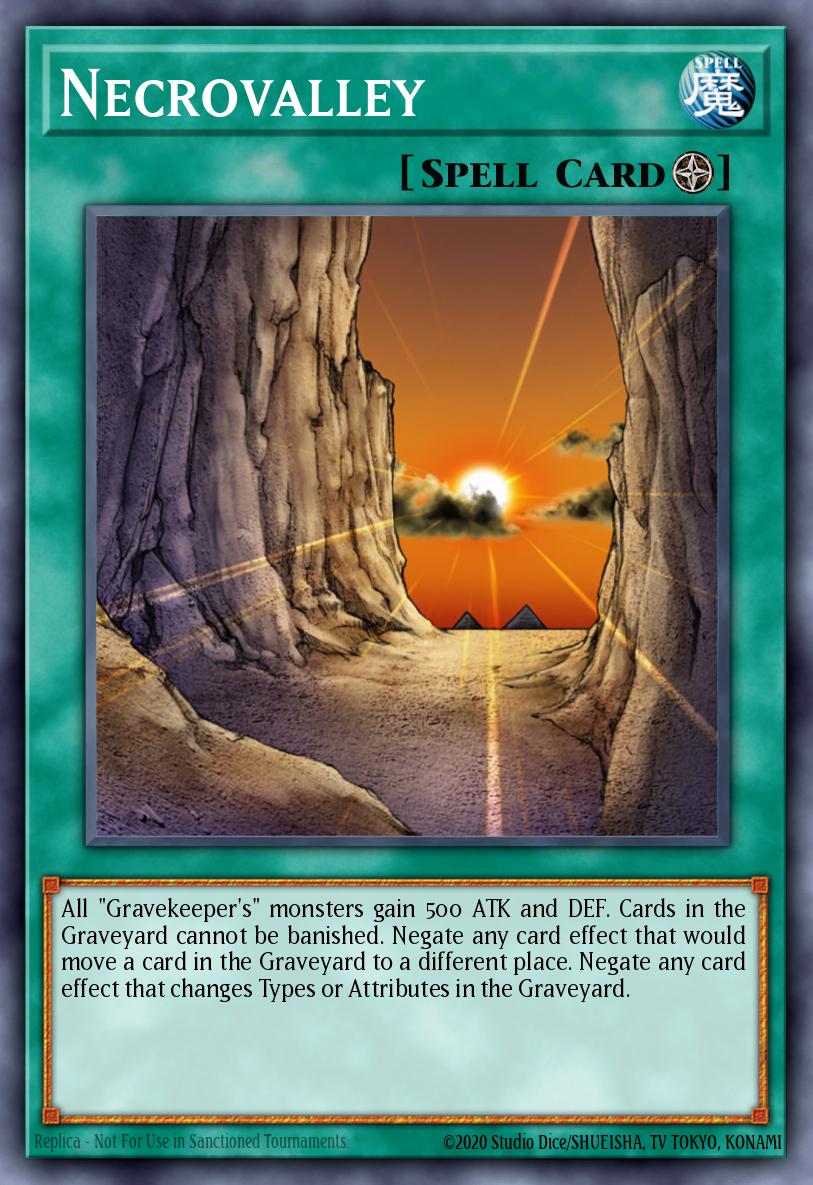 Despite having 7 changes, this still isn't the card with the most erratas.
Despite having 7 changes, this still isn't the card with the most erratas.The final card we will be talking about is an interesting one. Necrovalley is one of the few cards that has had a total of 7 errata. However, it differs from the other ones in the fact that each errata changes its power level.
Because there are too many changes to Necrovalley, I will limit the discussion to only the 2 most recent iterations.
Both errata share the effects that all "Gravekeeper" monsters gain 500 ATK/DEF, and cards in the GY cannot be banished. They also share an effect that negates card effects that move a card out of the GY. However, Konami took out one small line of text from the most recent erratum. In the version of Necrovalley released in Legendary Collection 3: Yugi's World, the restriction was lifted if a card would move itself out of the GY. Thus, cards like Glow-Up Bulb and Spore can Special Summon themselves from the GY; they use their own effect to do so and don't rely on outside help to be summoned.
Konami removed this line of text on the most recent erratum in Duelist Saga, making it so that cards cannot escape the GY.
Also, for some reason, this erratum negates cards that change Types/Attributes in the GY. This is unique in that it's a functional erratum that increases the card's power level instead of decreasing it.
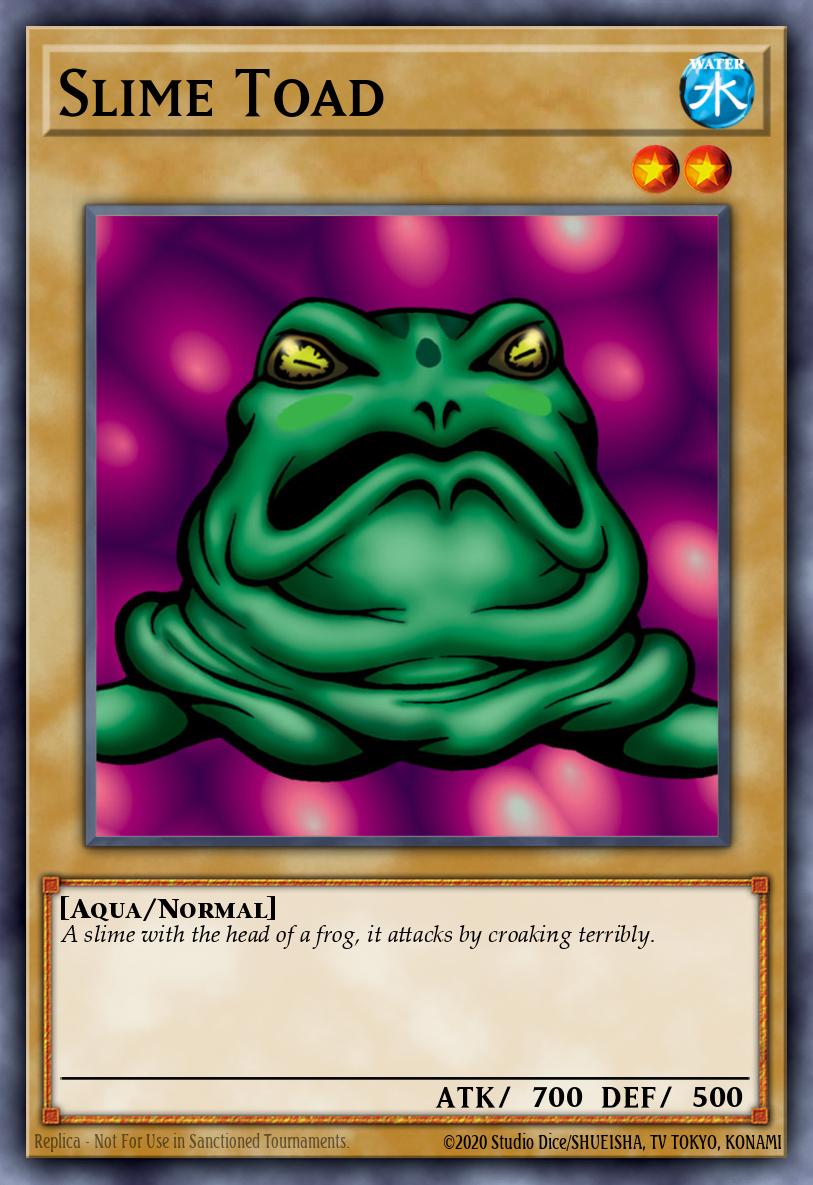 I refuse to call this card anything other than "Frog the Jam".
I refuse to call this card anything other than "Frog the Jam".Final Thoughts
Before we go, I want to point out that there are many more ways in which Konami may make erratas on cards. Types or Attributes of cards, or their ATK/DEF values, may change. They may change the names of cards (usually to avoid having to write "except 'Frog the Jam'" on every card due to a mistranslation from the OCG). They can add a clause to make a card always be treated as part of an archetype (Summoned Skull is always treated as an "Archfiend" card, for example). Konami can change these cards in many more ways.
If there is one idea I want you to take away from this article, it is that Konami makes an errata to make the card game easier for all players. It may be confusing having to keep track of all the changes, but it is our responsibility to know all of this before playing.
Luckily for us, we have an online card database to see these changes.




